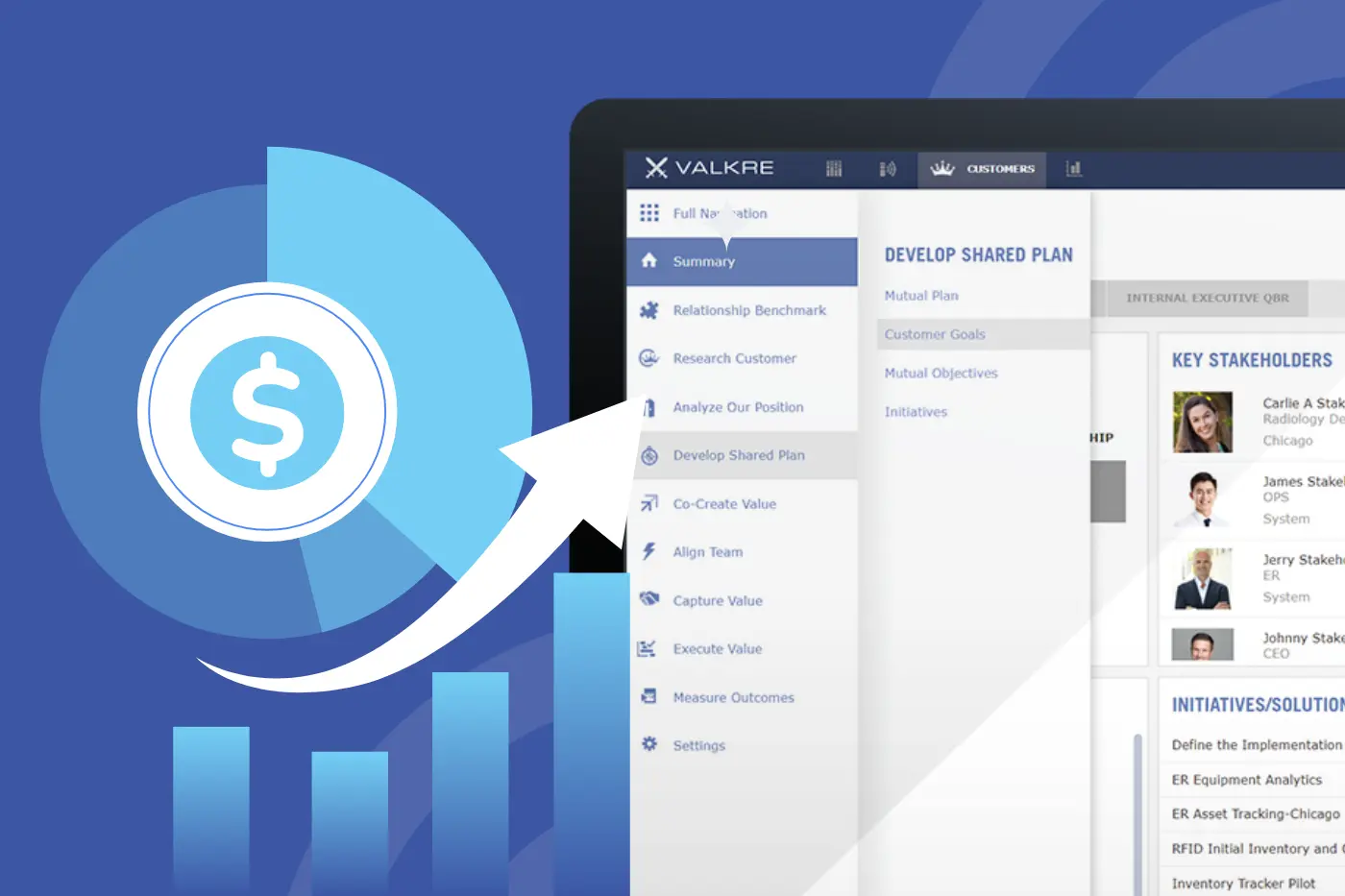Key Account Management (KAM) is growing as a crucial strategy for nurturing and expanding relationships with a company's most important customers. However, to excel in KAM, organizations must ensure they have the right technology in place. Just as a product development team needs tools like JIRA, or a marketing team requires solutions like Marketo, a KAM team also demands technology tailored to their unique processes and objectives.
KAM involves a multi-disciplined team engaged in a process that is distinctly different than traditional sales. The KAM team works from the top down with a focus on transforming their accounts into valuable, long-term partnerships. Deals are important of course but are a result of great customer engagement.
Classic cause and effect: Cause = Key Account Management, Effect = Deals.
As the KAM Model has grown, so has the understanding of people and process best practices. The problem is that the different roles of people and the processes associated with KAM are poorly supported by technology. The need for KAM Technology is high and fundamentally a hindrance for many companies whose strategy is to grow their Key Accounts using the KAM model.
KAM TECH CURRENT SITUATION
The most common approach to KAM Technology feels like anything but purpose-built Technology. It is rather more like Tech Spaghetti.

Tech Spaghetti leads to challenges that reduce the ability of companies to be effective and grow KAM.
What is Required of KAM Technology
This is a classic situation of understanding Process and People and then enabling both with Technology.
Process
Building KAM Tech starts with the Process. The Strategic Account Management Association (SAMA), having been around for 60 years, has a well-researched process. There are others, of course, but here are steps in the typical KAM process:
- Customer Discovery: Understand the customers' goals and the challenges they face in achieving them.
- Company Objectives: Define your company objectives and strategies for this customer.
- Account Planning: Build a plan that connects and shows what the two companies can do together to achieve the Customer’s Goals and your Company's Objectives.
- Outcomes: Quantify the customer outcomes from executing account plan initiatives. Identify deals and opportunities for your own company.
- Team Alignment: Identify and establish the teams internally and externally necessary to govern and execute.
- Execute the Plan: Establish discipline around how teams work together and communicate with each other.
- Measure and Adjust: Measure results and monitor progress toward improving the engagement model.
Within these general process steps, there are all sorts of powerful subprocesses, such as Stakeholder Analysis, White Space Analysis, Customer Journey Mapping, SWOT, Business Case Development, Financial Planning, Product Placement, Share Analysis, and so many more.
Every Company, Business Unit, Customer Segment, and Country has its own view about what process and subprocess is right for them. KAM Tech must be flexible enough to allow these differing process dosages while still holding together a harmonized approach to KAM within a given company. A harmonized approach yields consistent data and the ability to create dashboards enabling management of the overall KAM function.
People
The People component is so critically important and often overlooked in KAM Tech. Everyone automatically thinks that KAM Tech is for KAMs. The KAM may be the quarterback, but you don’t get anything done between two companies of any size with a person. It takes a team! Executives, Product Managers, Operations, Marketing, Project Teams. Many of these people do not even interact with traditional selling technology.
Another thing that tends to be true with large, important customers (Key Accounts) is that everyone wants to know “how’s it going,” “what’s going on,” “are they happy,” “are we growing,” “is Jack still there,” “will they like this new product.” And for multi-national, multi-divisional companies, you can multiply those questions by 10.
So, KAM Tech has to be built with multiple roles in mind. The actual KAM is tasked with thinking strategically and building an account plan. All the subprocess tools, such as SWOT and Stakeholder Analysis, are critical. They are tasked with executing the Account Plan, keeping Business Teams informed, and getting results. Here, they need KAM Tech to help them build these communication deliverables so they do not get bogged down in an endless loop of PPT creation.
The team supporting the KAM may just want to see the Initiatives or projects they are involved with and the work that needs to be completed. On the customer's side, efforts around executing account plans are important to them as well. KAM Tech should create out-of-the-box Customer QBRs.
The permutations are quite endless when you start considering the different roles and information needed by each and getting everyone on the same page via communication. This is where KAM Tech earns its keep – KAM teams with good KAM Tech can operate far more efficiently than their PPT contemporaries, making them faster and more agile.
KAM Tech is Not a Traditional CRM
No traditional CRM technology in this world fulfills the Process and People requirements of KAM. This point is the very reason why there is a KAM Tech spaghetti mess. Companies have tried their best to patch this thing together as the KAM function has grown into a strategic business driver. They have failed.
KAM Technology has rapidly become a foundational element for KAM success. The Strategic Account Management Association (SAMA) now identifies KAM Technology as a Key Driver for Successful KAM Programs. Esteemed vendors like Gartner and Forrester are now covering the KAM space, a testament to the growing importance of these functions in business strategy. These firms have long been the guiding light for businesses looking to stay ahead of technology trends. Their attention to specialized KAM tools underscores the need for platforms beyond generic functionalities and offering targeted solutions for key account growth and management.
KAM TECH ELIMINATES THE SPAGHETTI MESS
KAM Tech is a powerful entrant into the KAM Scene. It is measurably improving the effectiveness and efficiency of the overall KAM go-to-market approach. KAM Technology also needs to recognize the need to operate within a system of technology tools that are critical to a company's overall success.
- CRM and MDM Systems
Most companies have CRM (Customer Relationship Management) systems like Salesforce, SAP, and Microsoft Dynamics In the context of Sales Technology, they function to manage a transactional sales process. In this capacity, they become databases housing critical information on accounts, contacts, transactions, pipeline opportunities, and campaigns.
MDM (Master Data Management) tools such as Reltio or Informatica are growing as a source for exactly what the name implies, Master Data. So, instead of having what would be considered a “source of record” data in a CRM, you house it in an MDM where all other systems can access the data.
- Business Intelligence Platforms
Tools like Tableau step in as powerful business intelligence (BI) platforms. They are instrumental in visualizing and making sense of disparate datasets. A BI tool can transform raw data into actionable insights, helping KAM teams understand customer behaviors, preferences, and trends. This insight is crucial for developing targeted strategies that resonate with key accounts.
- Paid Data Sources and AI Engines
In the realm of discovery and research, paid data sources and AI engines such as ChatGPT and ZoomInfo are game-changers. They assist in gathering deep insights about market trends, customer needs, and competitive landscapes. This information is vital for KAM teams to stay ahead of the curve and position their offerings more effectively.
The point is that KAM Tech needs to connect to these systems so that KAMs can do their work but also so the Tech Systems are updated as a result of the KAMs work. In this way, KAMs are becoming part of an overall Technology System, which they currently are not. And, since they are not, the Technology System is woefully lacking data related to a company’s most important Customers
THE FUTURE OF KAM TECHNOLOGY
While CRM, BI tools, and data sources have been staples in the business technology arsenal for some time, the landscape of Key Account Management is witnessing a significant evolution.
Industry Recognition: A Testament To The Need For Specialized Tools
Esteemed vendors like Gartner and Forrester are now covering the Account Planning and Account Management space, a testament to the growing importance of these functions in business strategy. These firms have long been the guiding light for businesses looking to stay ahead of technology trends. Their attention to specialized KAM tools underscores the need for platforms beyond generic functionalities and offering targeted solutions for key account growth and management.
The Role Of AI And Machine Learning In Enhancing KAM
Incorporating AI and machine learning into your KAM tech can transform how you manage key accounts. AI-driven tools can analyze vast amounts of data to provide predictive insights, identify cross-sell and up-sell opportunities, and even suggest personalized engagement strategies for each key account. Machine learning algorithms can continuously learn from interactions and outcomes, improving the quality of insights and recommendations provided.
Emphasizing Security And Compliance In Your KAM Tech
In the era of data breaches and stringent privacy regulations, ensuring the security and compliance of your KAM tech is paramount. This means choosing platforms and tools that protect sensitive customer data and comply with global data protection regulations like GDPR.
FINAL THOUGHTS
The adoption of KAM Tech marks a transformative shift from reliance on ad-hoc tools like Microsoft Word, Excel, and PowerPoint. While familiar and versatile, traditional tools often fall short of meeting the dynamic and complex needs of effective key account management. In this environment, the limitations inherent in general-purpose tools like Word and Excel can lead to fragmented account overviews and inefficient management practices.
The right technology for KAM is a strategic asset that can significantly enhance your ability to manage and grow key accounts. It's about creating a synergy between people, processes, and technology to drive success in account management. Optimized and well-thought-out KAM Tech is pivotal in today's competitive business environment. It's about having the right tools and ensuring these tools work together seamlessly to provide a comprehensive, efficient, and secure KAM process.
By carefully selecting and integrating CRM systems, BI tools, AI engines, and a unified KAM platform, you can set your team up to achieve remarkable results in key account management.
Remember, in the world of KAM, your technology is not just a facilitator; it's a catalyst for building lasting and profitable relationships with your most important customers.
Book a demo with us to enable effective Key Account Management: https://www.valkre.com/contact-us?GetStarted=True


.png)


